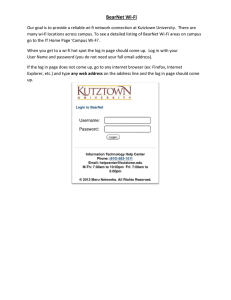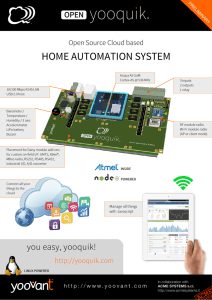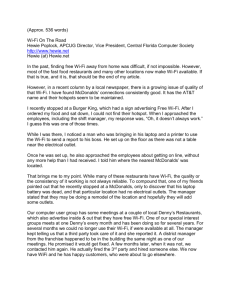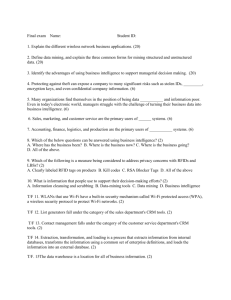Conclusions Results Abstract
advertisement
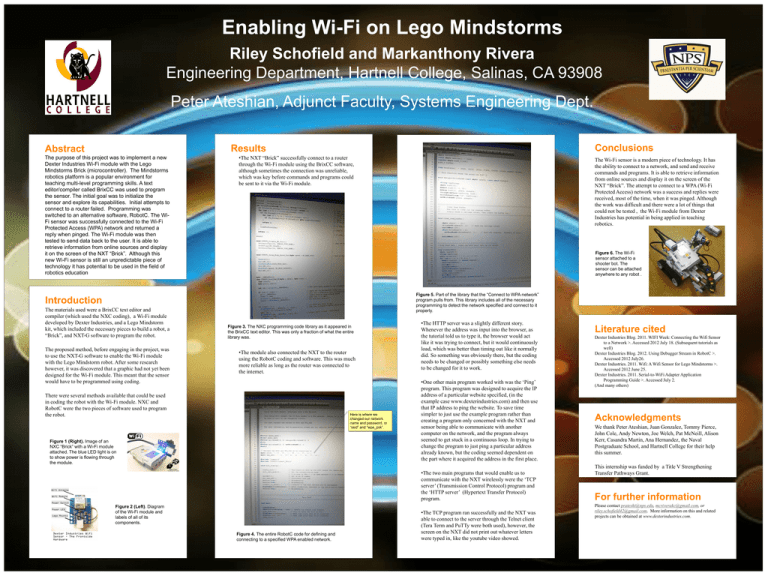
Enabling Wi-Fi on Lego Mindstorms Riley Schofield and Markanthony Rivera Engineering Department, Hartnell College, Salinas, CA 93908 Peter Ateshian, Adjunct Faculty, Systems Engineering Dept. Conclusions Results Abstract The purpose of this project was to implement a new Dexter Industries Wi-Fi module with the Lego Mindstorms Brick (microcontroller). The Mindstorms robotics platform is a popular environment for teaching multi-level programming skills. A text editor/compiler called BrixCC was used to program the sensor. The initial goal was to initialize the sensor and explore its capabilities. Initial attempts to connect to a router failed. Programming was switched to an alternative software, RobotC. The WiFi sensor was successfully connected to the Wi-Fi Protected Access (WPA) network and returned a reply when pinged. The Wi-Fi module was then tested to send data back to the user. It is able to retrieve information from online sources and display it on the screen of the NXT “Brick”. Although this new Wi-Fi sensor is still an unpredictable piece of technology it has potential to be used in the field of robotics education •The NXT “Brick” successfully connect to a router through the Wi-Fi module using the BrixCC software, although sometimes the connection was unreliable, which was key before commands and programs could be sent to it via the Wi-Fi module. Figure 6. The Wi-Fi sensor attached to a shooter bot. The sensor can be attached anywhere to any robot . Figure 5. Part of the library that the “Connect to WPA network” program pulls from. This library includes all of the necessary programming to detect the network specified and connect to it properly. Introduction The materials used were a BrixCC text editor and compiler (which used the NXC coding), a Wi-Fi module developed by Dexter Industries, and a Lego Mindstorm kit, which included the necessary pieces to build a robot, a “Brick”, and NXT-G software to program the robot. The proposed method, before engaging in the project, was to use the NXT-G software to enable the Wi-Fi module with the Lego Mindstorm robot. After some research however, it was discovered that a graphic had not yet been designed for the Wi-Fi module. This meant that the sensor would have to be programmed using coding. The Wi-Fi sensor is a modern piece of technology. It has the ability to connect to a network, and send and receive commands and programs. It is able to retrieve information from online sources and display it on the screen of the NXT “Brick”. The attempt to connect to a WPA (Wi-Fi Protected Access) network was a success and replies were received, most of the time, when it was pinged. Although the work was difficult and there were a lot of things that could not be tested , the Wi-Fi module from Dexter Industries has potential in being applied in teaching robotics. Figure 3. The NXC programming code library as it appeared in the BrixCC text editor. This was only a fraction of what the entire library was. •The module also connected the NXT to the router using the RobotC coding and software. This was much more reliable as long as the router was connected to the internet. There were several methods available that could be used in coding the robot with the Wi-Fi module. NXC and RobotC were the two pieces of software used to program the robot. Here is where we changed our network name and password, or “ssid” and “wpa_psk”. Figure 1 (Right). Image of an NXC “Brick” with a Wi-Fi module attached. The blue LED light is on to show power is flowing through the module. •The HTTP server was a slightly different story. Whenever the address was input into the browser, as the tutorial told us to type it, the browser would act like it was trying to connect, but it would continuously load, which was better than timing out like it normally did. So something was obviously there, but the coding needs to be changed or possibly something else needs to be changed for it to work. •One other main program worked with was the ‘Ping’ program. This program was designed to acquire the IP address of a particular website specified, (in the example case www.dexterindustries.com) and then use that IP address to ping the website. To save time simpler to just use the example program rather than creating a program only concerned with the NXT and sensor being able to communicate with another computer on the network, and the program always seemed to get stuck in a continuous loop. In trying to change the program to just ping a particular address already known, but the coding seemed dependent on the part where it acquired the address in the first place. •The two main programs that would enable us to communicate with the NXT wirelessly were the ‘TCP server’ (Transmission Control Protocol) program and the ‘HTTP server’ (Hypertext Transfer Protocol) program. Figure 2 (Left). Diagram of the Wi-Fi module and labels of all of its components. Figure 4. The entire RobotC code for defining and connecting to a specified WPA enabled network. •The TCP program ran successfully and the NXT was able to connect to the server through the Telnet client (Tera Term and PuTTy were both used), however, the screen on the NXT did not print out whatever letters were typed in, like the youtube video showed. Literature cited Dexter Industries Blog. 2011. WIFI Week: Connecting the Wifi Sensor to a Network >. Accessed 2012 July 18. (Subsequent tutorials as well) Dexter Industries Blog. 2012. Using Debugger Stream in RobotC >. Accessed 2012 July26. Dexter Industries. 2011. Wifi: A Wifi Sensor for Lego Mindstorms >. Accessed 2012 June 25. Dexter Industries. 2011. Serial-to-WiFi Adapter Application Programming Guide >. Accessed July 2. (And many others) Acknowledgments We thank Peter Ateshian, Juan Gonzalez, Tommy Pierce, John Cole, Andy Newton, Joe Welch, Pat McNeill, Alison Kerr, Casandra Martin, Ana Hernandez, the Naval Postgraduate School, and Hartnell College for their help this summer. This internship was funded by a Title V Strengthening Transfer Pathways Grant. For further information Please contact prateshi@nps.edu, mcriverakc@gmail.com, or riley.schofield42@gmail.com. More information on this and related projects can be obtained at www.dexterindustries.com.
